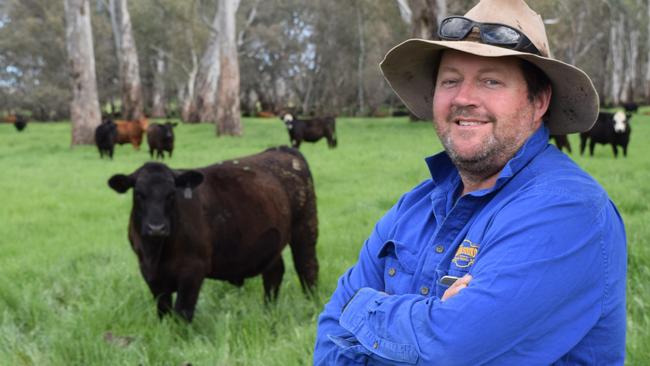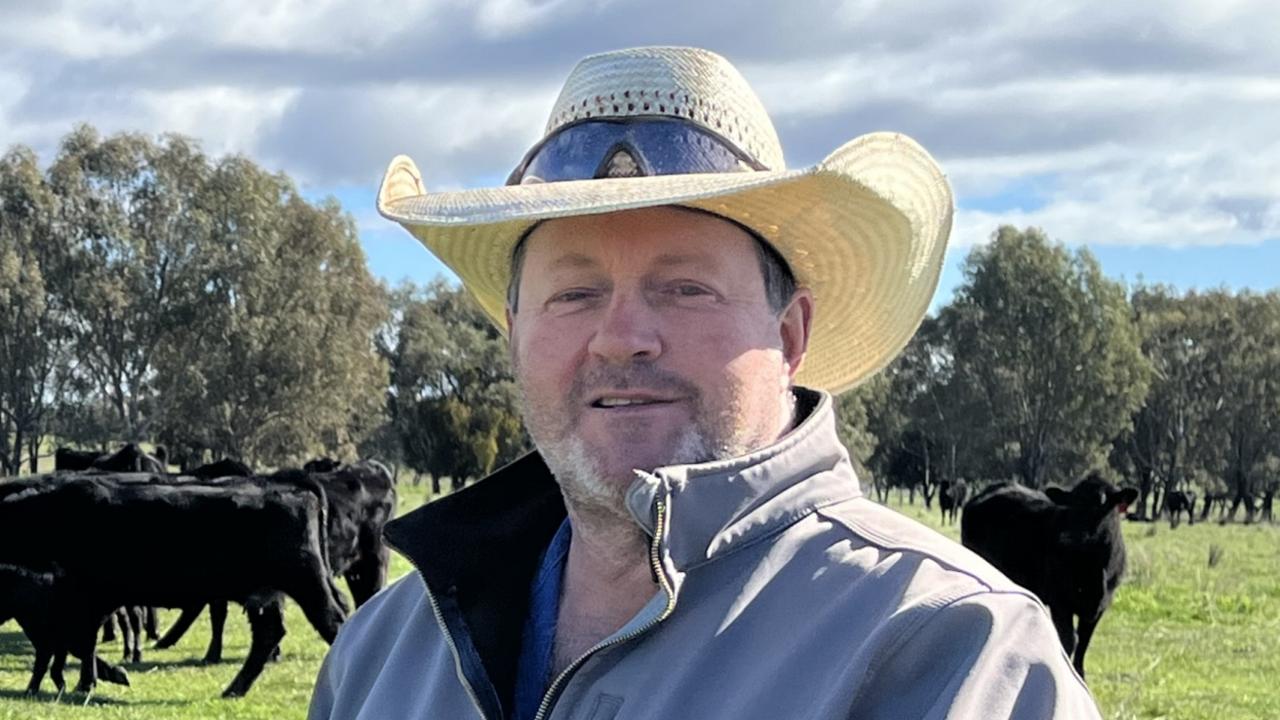Karn Station: Benalla farmer Tim Stokes farms by numbers
A GOOD mix of beef and sheep makes sense for Karn Station, writes JAMIE-LEE OLDFIELD.

NOTHING happens by chance at Karn Station. Except perhaps the weather.
For manager Tim Stokes, it is important to do the sums, and plan accordingly.
The avid dog man mixes old — he has horses tied up out the back — with new — a drone used to check water points sits next to his desk.
Tim has managed Peter and Jill Loyd’s Karn Station at Benalla, in Victoria’s North East, for the past five years of their 15-year ownership.
The 1750ha property runs 1000 beef cattle and close to 3000 maternal composite ewes.
Both sides of the operations rely on two main elements for success — feed efficiency and savvy marketing.
“We are a spring operation, we lamb and calve early and maximise the spring growth and by Christmas, we are selling and winding off — that is our key driver,” Tim said.
Originally Angus and Hereford, the cow herd is now 70 per cent Stabilizer, red and black.
The Stabilizer breed was developed by Leachman Cattle Company in the US, made up of Angus, Hereford, Simmental and Gelbvieh.
Tim gets his Stabilizer genetics from Paringa stud at Yea, and said both the return client demand for the progeny, and impressive feed conversion data, meant the entire herd would be Stabilizers soon.
Those return clients include Oakey Holdings in Queensland, which buys Karn Station steers about 440-480kg at 12-15 months.
“Oakey keep coming back, chasing our steers and I know we are getting a reasonable premium above standard market price, so they are performing for them up there,’ he said.
CONTRACT HIT
TIM said forward contracting was an important aspect of marketing stock for Karn Station.
“Especially if we are feeding cattle, it gives us the security, we can do the economics around that and know whether we should or shouldn’t be feeding,” he said.
“Oakey will also give us the weight gain and kill data ... and this year in particular, because we are seeing the first full run of Stabilizers come through, we will be chasing it quite hard.”
Before the August-drop calves turn into feeders, however, they are yard weaned and broken in with dogs, before being put out on to irrigated pasture and grain.
“That is to set their rumens up and promote rumen development,” Tim said. “And, depending on the autumn, they will go back on to feed pens (grain and silage) for 40 to 50 days, before going back on to grass to finish.
“The target in feed pens is 1kg (weight gain) a day and the ration is set up for that. We usually get better results, though, our Stabilizers’ feed efficiency is quite amazing.
“We have been doing 1.3kg for the steers — it shows the improved genetics are starting to flow through.”
Stabilizers not only offer the hybrid vigour Tim is looking for, but they are also more cost efficient, with bulls yet to have reached the high commercial prices of some other breeds.
“In the end, economics is the main driver,” he said.
Some Angus genetics are still used at Karn Station, with 200 of the 300 heifers — all joined at 12 months — artificially inseminated to Lawsons Angus sires.
Tim then follows the progeny of those joinings through from when the herd calves in August to processing, returning the data to Lawsons principal Harry Lawson.
“We take the first weight at calf marking in late September. Every time they are handled after that we usually weigh and that data is all kept and passed on to as what sire is doing what,” he said.
“And we have been getting some pretty powerful information out of that. It is quite amazing when you start tracking what the different sires do.”
FEED FOR THOUGHT
TIM says the business is all about feed efficiency.
“We get a really good indicator, especially when we put them on feed, of how much feed is going into how much beef produced. It is all about grass grown and kilograms of beef turned off,” he said.
“That’s the information we are after. And we can do it on an individual basis. The AI calves, in particular, are tagged with sire tag, so we can visually look at those in the paddock as well. And our cows are syndicate joined to certain bulls, so we know which bulls went to which age group of cows, so we can follow those sire groups through as well.”
Stocking rates mean there is no room for error at Karn, and “everything that is here has to be productive”, Tim said.
“We rotational graze and every paddock has a centre water trough and then it is divided into four, so we do a lot of cell grazing to use grass grown,” he said.
Pastures are made up of predominantly phalaris and clover, with ryegrass used in the renovation program each year. The farm is soil tested every year, at a cost of $10,000-$11,000, but Tim says it pays for itself.
“We use Jim Shovelton from Meridian and he gives us recommendations back on each paddock,” he said.
“It is big investment but if you look over whole fertiliser program it justifies the cost.
“Our fertiliser regimen is set up to run 18-20 DSE/ha, so each individual paddock is broken down and it gets what it needs to do that.”
The property is broken into 130 paddocks, with those paddocks often split into four cells.
“When we have a water leak it can take quite a long time to find ... we can fly the drone across a block in six to seven minutes that would take an hour to drive across,” Tim said.
“I’ve also programmed the drone to map all the water troughs and I can set it and it will do it itself and I can look at photos when I get home.
“It might also be useful at lambing to see cast ewes — that is the only real problem we have at lambing.”
CHOP SHOP
THE sheep flock, based on Lambpro genetics from Tom Bull at Holbrook, has risen from 1000 ewes five years ago, to 3000 now.
“And the plan is to keep building on that and back the cow job off,” Tim said.
“The beef job has been good the past couple of years, but if you look at sheep for the past seven years, the fat lamb job has been more consistent.”
Half the maternal composite ewes are joined to terminal Poll Dorset sires, while the remainder are put back over materials to breed replacement females.
Ewes are joined at the end of January, and a month out from joining they are put on to a grain and silage mix, as well as being introduced to teasers.
A short joining means a short lambing period, and this year Tim marked 152 per cent of lambs from his mature ewes, and 124 per cent from ewe lambs.
After a five-week mating, 97 per cent are back in lamb.
And as with the cattle, the sheep operation does not have any room for passengers — if ewes do not rear a lamb, they are sold, along with all the empty females.
Ewes are scanned for twins and singles, while the cows are pregnancy tested at 32-35 days, to offload empties sooner.
After a July lambing, the progeny is turned off in October and November, with the season dictating how they are sold.
This year, having only received 367mm of rain to the end of September, compared with 736mm last year, 1000 were sold as store lambs.
Those finished on property are usually sold through Coles.
“The store job has been strong, so I take the money and run — we assess the season and prices with agent Mick Curtis, of Rodwells Euroa, and go from there,” Tim said.
“We are always looking out in front, that is why we like forward contracting.
“If there is an option that might suit our program we can put stock into it — we are always looking to value add, I don’t just get up and say we have to sell something today, it is a planned event.”


